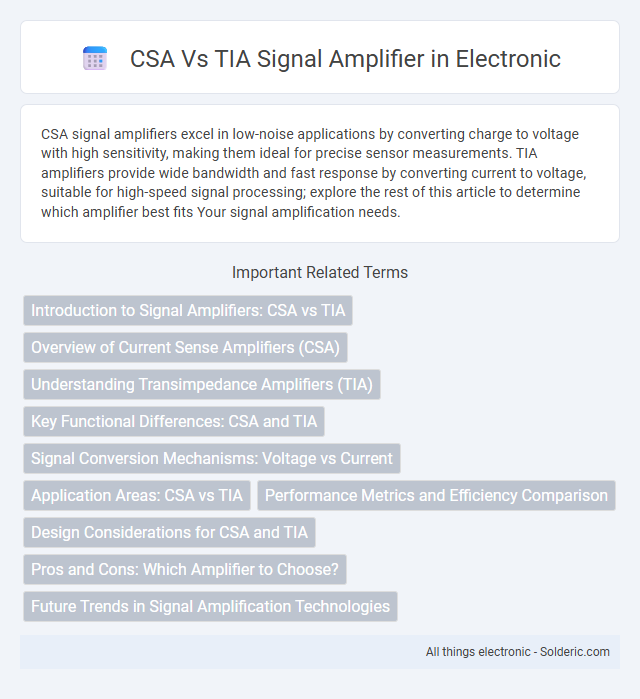CSA signal amplifiers excel in low-noise applications by converting charge to voltage with high sensitivity, making them ideal for precise sensor measurements. TIA amplifiers provide wide bandwidth and fast response by converting current to voltage, suitable for high-speed signal processing; explore the rest of this article to determine which amplifier best fits Your signal amplification needs.
Comparison Table
| Feature | CSA (Charge Sensitive Amplifier) | TIA (Transimpedance Amplifier) |
|---|---|---|
| Primary Function | Converts input charge to output voltage | Converts input current to output voltage |
| Typical Application | Radiation detectors, capacitive sensors | Photodiodes, optical sensors |
| Input Signal | Charge pulses | Current signals |
| Feedback Element | Feedback capacitor | Feedback resistor (usually) |
| Noise Characteristics | Low noise for high-impedance inputs | Optimized for low current noise |
| Bandwidth | Limited by feedback capacitance | Broader bandwidth, higher speed |
| Output | Voltage proportional to input charge | Voltage proportional to input current |
| Sensitivity | High sensitivity to small charge | High sensitivity to current variations |
Introduction to Signal Amplifiers: CSA vs TIA
Current Sense Amplifiers (CSA) and Transimpedance Amplifiers (TIA) play crucial roles in converting input currents into measurable voltages. CSA is optimized for precise current measurement with high sensitivity, often used in applications requiring accurate current sensing and monitoring. TIA excels in converting low-level photodiode currents into voltage signals, making it ideal for optical communication and sensor interfacing, ensuring Your system captures and amplifies weak signals effectively.
Overview of Current Sense Amplifiers (CSA)
Current Sense Amplifiers (CSA) provide precise measurement of current flow by amplifying voltage drop across a shunt resistor, enabling accurate current monitoring in power management and battery applications. CSAs offer high common-mode voltage range, low offset voltage, and low input bias current, ensuring reliable performance under varying operating conditions. They differ from traditional TIA (Transimpedance Amplifier) circuits by focusing on current detection rather than converting photodiode current to voltage, making CSAs ideal for real-time current sensing in electronic systems.
Understanding Transimpedance Amplifiers (TIA)
Transimpedance amplifiers (TIAs) convert input current signals into proportional output voltage, making them essential in photodetector applications for precise optical signal measurement. TIAs offer high bandwidth and low noise performance by integrating feedback resistors and amplifying photodiode current directly, unlike current-sense amplifiers (CSAs) that primarily measure current with less frequency response. Optimizing TIA design involves balancing gain, bandwidth, and noise to enhance signal integrity in high-speed optical communication and sensor systems.
Key Functional Differences: CSA and TIA
A Charge Sensitive Amplifier (CSA) converts input charge directly into a proportional voltage, making it ideal for detecting and measuring charge pulses in radiation detectors. A Transimpedance Amplifier (TIA) converts input current into a voltage output with a defined gain, commonly used for photodiodes and current signal amplification. The CSA excels in integrating charge over time, while the TIA provides fast, linear current-to-voltage conversion with low input impedance.
Signal Conversion Mechanisms: Voltage vs Current
A CSA (Charge Sensitive Amplifier) converts input charge signals into voltage output, offering high sensitivity and low noise, ideal for detecting low-level signals in applications like radiation detection. TIA (Transimpedance Amplifier) converts input current directly into voltage, providing fast response times and precise current-to-voltage conversion crucial for photodiode and optical sensor interfaces. Your choice between CSA and TIA hinges on whether the signal source naturally produces charge pulses or current, impacting amplification efficiency and signal fidelity.
Application Areas: CSA vs TIA
Current Sense Amplifiers (CSA) are primarily used in applications requiring precise current measurement, such as battery monitoring, power management, and sensor interfacing. Transimpedance Amplifiers (TIA) excel in converting low-level current signals to voltage, making them ideal for photodetector signal amplification, optical communication, and medical instrumentation. Both amplifiers enhance signal fidelity but are chosen based on specific application needs involving current measurement or optical signal conversion.
Performance Metrics and Efficiency Comparison
CSA signal amplifiers provide superior noise performance with lower input-referred noise, enhancing sensitivity in low-level signal applications. TIA amplifiers offer higher bandwidth and faster response times, making them ideal for high-speed optical communication systems. Your choice depends on whether noise minimization or speed efficiency is the primary performance metric for your application.
Design Considerations for CSA and TIA
Design considerations for a Charge Sensitive Amplifier (CSA) emphasize minimizing input capacitance and noise to optimize charge detection in applications like radiation sensors. Transimpedance Amplifiers (TIA) require careful selection of feedback resistor values to balance bandwidth and gain, ensuring accurate current-to-voltage conversion in photodiode interfaces. Both CSAs and TIAs demand stability analysis and layout strategies to reduce parasitic effects and enhance signal integrity.
Pros and Cons: Which Amplifier to Choose?
CSA (Current Sense Amplifier) offers high accuracy in low-level current measurements with excellent noise immunity, ideal for precision sensing applications. TIA (Transimpedance Amplifier) excels at converting low-level currents to voltage signals with fast response times, making it suitable for photodiode and sensor interface circuits. Choosing between CSA and TIA depends on the required signal bandwidth, noise performance, and application-specific parameters such as input current range and output stability.
Future Trends in Signal Amplification Technologies
Future trends in signal amplification technologies emphasize the integration of CSA (Charge Sensitive Amplifiers) and TIA (Transimpedance Amplifiers) with advanced semiconductor materials such as SiGe and GaN to enhance bandwidth and noise performance. Innovations in low-power design and adaptive feedback mechanisms aim to optimize signal fidelity in high-speed communication and sensing applications. The evolution toward integrated photonic and electronic amplification modules promises significant improvements in miniaturization and energy efficiency for next-generation signal processing systems.
CSA vs TIA signal amplifier Infographic

 solderic.com
solderic.com